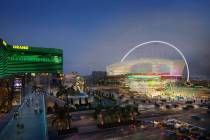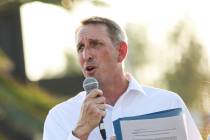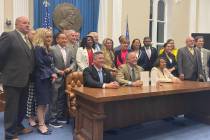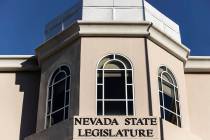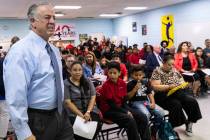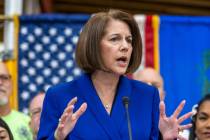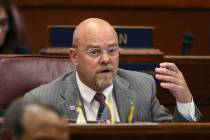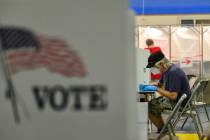Waiting on California’s trains
If you’ve ever been struck in a traffic jam on Interstate 15 between Las Vegas and California, you might become more sympathetic to the idea of the Xpress West high-speed train.
With just two traffic lanes for a critical portion of the route between Victorville and Primm, even a minor traffic accident on I-15 can sometimes mean hours of delays. The notion of cruising along at more than 150 miles per hour is a dream come true for beleaguered travelers spending their eighth hour behind the wheel in crawling bumper-to-bumper traffic.
Nevada’s congressional delegation took a step last week to help the train’s development. A bill by Sen. Dean Heller (co-sponsored by Sen. Harry Reid and Reps. Joe Heck, Mark Amodei and Cresent Hardy) would transfer 520 acres of the Mojave National Preserve from the jurisdiction of the National Park Service to the Bureau of Land Management. According to Heller, the BLM has a more streamlined process to allow for infrastructure development. It also allows for a shorter, more efficient route for the train.
“We need an ‘all of the above’ approach when it comes to addressing our transportation needs and enhancing tourism opportunities for Las Vegas,” Heller said in a statement. “The XpressWest rail project will promote economic development and significantly boost tourism to Nevada, benefiting our state for years to come.”
The benefits of the train are obvious. More tourists making quicker, less stressful trips to Las Vegas. Catering to foreign tourists who are used to riding trains in Europe and Asia. Less traffic on Interstate 15, and less pollution. Easier commutes for Southern California expatriates returning home for holidays such as Thanksgiving and Christmas.
But those benefits rest on some big assumptions, too, not least of which is the construction of the California high speed rail system and the key connection of that system to the Xpress West station via a line from Victorville (where Xpress West ends) into Palmdale.
Xpress West backers have said the Victorville-Palmdale link isn’t absolutely necessary for the train itself to be a success. They envision drivers coming from Southern California to Victorville by car, and riding the train the rest of the way. There are enough potential tourists within the Victorville station to make it work, backers say.
That’s a dubious proposition, as far as I’m concerned. But even the train’s most ardent backers would agree that in order for Xpress West to reach its full potential, it must connect to the California system. The most recent alignment map on the California High Speed Rail Authority’s website shows no connection between Victorville and Palmdale, at least not yet.
Even more troubling for Xpress West are the delays experienced in building the $64.2 billion California system, which has been plagued by lawsuits, uncertain funding and missed deadlines. On Friday, news broke that the system will see another three-year delay in completing the project’s initial leg, between San Jose and the Central Valley. Completion isn’t expected until 2025.
And the Victorville-Palmdale link? It’s not too far to say that doesn’t seem to be a top priority for California planners, who are concentrating on the pitfalls of planning train routes through some of the most congested urban areas in the country. It’s been suggested that Xpress West could underwrite that portion of the route (it’s about 50 miles between the two cities), but even so, Las Vegas’ train is still dependent on California’s progress in completing the rest of its system.
Until that’s done, we’re waiting on California to make high-speed rail a reality.
Steve Sebelius is a Review-Journal political columnist and co-host of the show “PoliticsNOW,” airing at 5:30 p.m. Sundays on 8NewsNow. Follow him on Twitter (@SteveSebelius) or reach him at 702-387-5276 or SSebelius@reviewjournal.com.








